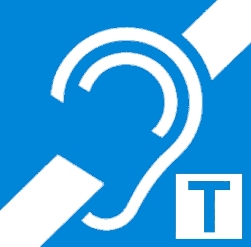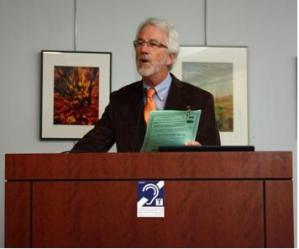 Using funding provided by a local chapter of the Hearing Loss Association of America (HLAA), the Greenburgh Public Library, NY (GPL) this spring installed an audio frequency induction loop (AFIL) in its multipurpose room. AFILs enable public address systems and other AV equipment to send audio transmissions directly to hearing aids, eliminating background noise for hearing impaired visitors.
Using funding provided by a local chapter of the Hearing Loss Association of America (HLAA), the Greenburgh Public Library, NY (GPL) this spring installed an audio frequency induction loop (AFIL) in its multipurpose room. AFILs enable public address systems and other AV equipment to send audio transmissions directly to hearing aids, eliminating background noise for hearing impaired visitors.
“It’s a pretty significant increase in fidelity for the end-user, because it gets rid of all the ambient noise,” said Leo Garrison, president and senior integration specialist for Washingtonville, NY-based Metro Sound Pros, the commercial AV company that installed Greenburgh’s loop.
During regular use, hearing aids are designed to amplify a specific frequency range in which an individual is experiencing hearing loss, Garrison said. But when a user is attending a public event, background noise can cause the sound to become muddled. AFILs bypass the hearing aid’s microphone/amplifier system, instead generating an electromagnetic field with a wire “loop” that encircles a room, transmitting audio information directly to the telecoil receiver installed in most hearing aids and cochlear implants. Although patrons may have to manually switch their hearing aids to “T-coil” mode to benefit from an AFIL system, no additional equipment is needed for users.
Garrison said he often draws a simple comparison to describe the enhancement in audio fidelity that the loops offer—it’s the difference between attending a concert with a loud, cheering crowd and listening to a recording of a song in a quiet room.
The new system “has worked well to serve everyone’s needs,” and cut down on issues in which attendees at meetings, film screenings, and other events either could not hear, or complained that the PA volume was too loud, said GPL Director John Sexton.
“We knew we had a need, because we have a growing population of seniors—as do most communities—and they are definitely a target audience for our programs,” he said.
 The local HLAA chapter, which also holds its board meetings in GPL’s multipurpose room, first approached the library about installing the system about two years ago. Since then, it has been a matter of securing financing for the loop, which cost about $5,000 to install, Sexton said. The HLAA chapter ultimately donated the money using a portion of the proceeds from their annual Walk4Hearing fundraiser.
The local HLAA chapter, which also holds its board meetings in GPL’s multipurpose room, first approached the library about installing the system about two years ago. Since then, it has been a matter of securing financing for the loop, which cost about $5,000 to install, Sexton said. The HLAA chapter ultimately donated the money using a portion of the proceeds from their annual Walk4Hearing fundraiser.
AFIL technology is not new. In fact the first patent for an induction loop hearing assistance system was issued in Great Britain in 1937. AFILs became more common in the 1970s, Garrison said, but early mishaps caused their popularity as a solution to wane in the United States.
“The problem was, manufacturers really didn’t have the knowledge and/or the equipment to successfully integrate with facilities,” Garrison said. “There were a lot of systems installed incorrectly, and looping got a really bad rep in the 70s. It was kind of forgotten about, until recently, with advocates and manufacturers pushing for it.”
The technology has since become mainstream in Europe, particularly in the United Kingdom, which requires the installation of AFILs in public buildings as a provision of the Equality Act 2010. Although the United States has been slower to adopt AFILs, HLAA is working to raise awareness, and Garrison said that Metro Sound Pros had been seeing renewed interest in loops. The company has been working with New York’s Metropolitan Transportation Authority (MTA) for a few years to install loops at 24 hour subway system station booths and was contracted to install systems in New York’s Intrepid Air & Space Museum, several educational institutions, banks, and retail establishments, as well as two Broadway theatres—the Gershwin Theatre and the Richard Rogers Theatre—during the past year alone.
And in addition to GPL, several other libraries have adopted the technology in recent years, primarily with limited installations at service desks, enhancing one-on-one conversations with hearing impaired patrons and library staff. This spring, for example, the Southwest Wisconsin Library System installed information desk loops at nine of its libraries using a grant from the Institute of Museum and Library Services (IMLS). And last month, Louisiana’s Lafayette Public Library System debuted a full meeting room loop installation similar to GPLs, in its South Region Library, using funding donated by the Lafayette Breakfast Sertoma Club, the Lafayette Sertoma Club and the Friends of the Lafayette Public Library.
Garrison said that Metro Sound has seen a lot of interest in the systems from libraries, particularly since 2011, when the New York Times ran a feature on the technology. But recession-impacted budgets have meant that few potential clients have been able to proceed immediately with an installation. He estimates that less than one percent of U.S. facilities are currently “looped.”
Outfitting a multi-purpose room such as GPLs typically costs between $5,000 to $8,000, Garrison said, and it’s easiest—and least expensive—to install an AFIL when a room or building is having its carpeting replaced or undergoing a broader remodeling effort.



We are getting ready to install a permanent loop in one of our meeting rooms.